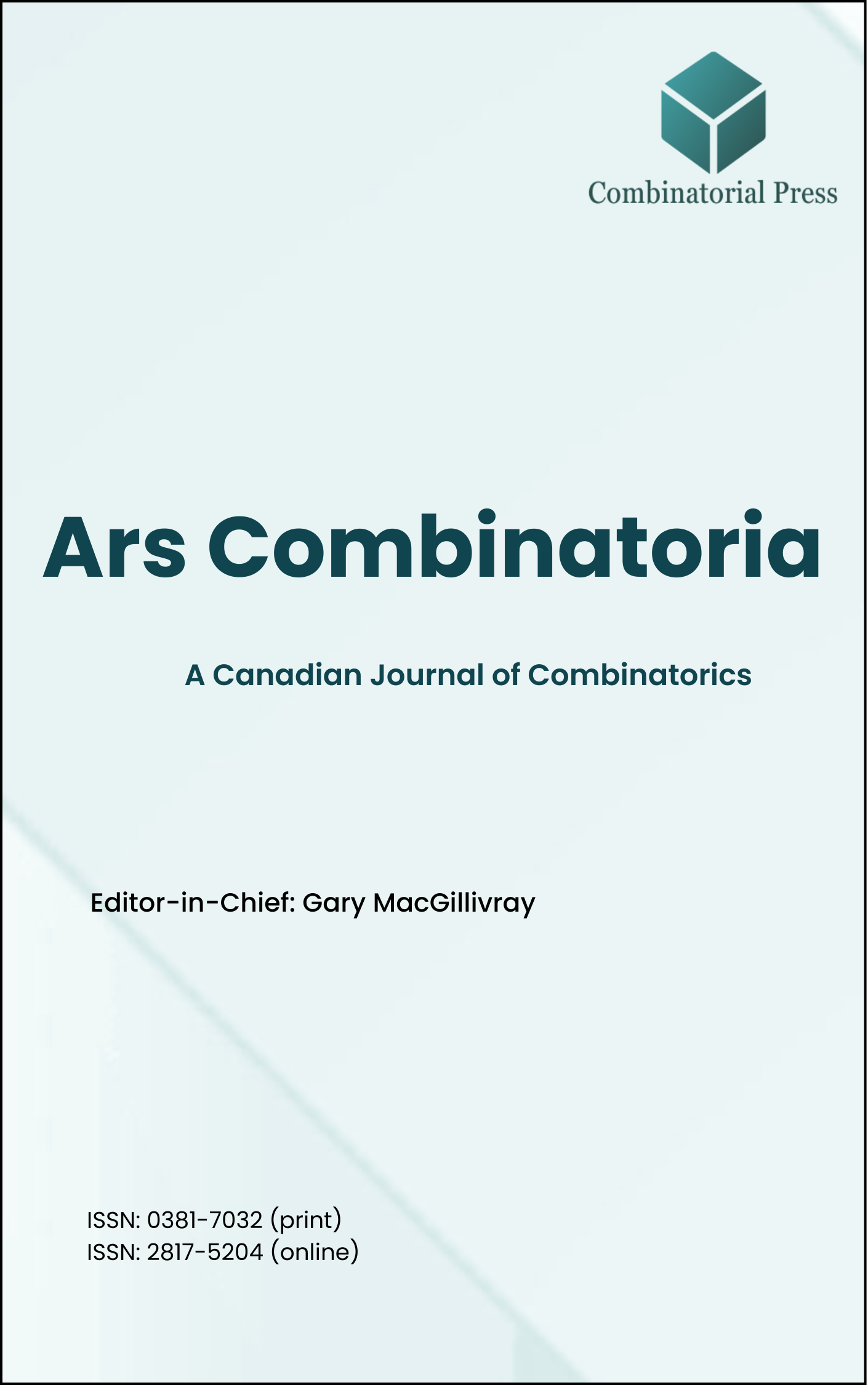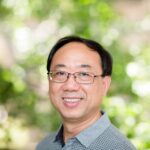
Ars Combinatoria
ISSN 0381-7032 (print), 2817-5204 (online)
Ars Combinatoria is the oldest Canadian Journal of Combinatorics, established in 1976. The journal is dedicated to advancing the field of combinatorial mathematics through the publication of high-quality research papers. From 2024 onward, it publishes four volumes per year in March, June, September and December. Ars Combinatoria has gained recognition and visibility in the academic community and is indexed in renowned databases such as MathSciNet, Zentralblatt, and Scopus. The Scope of the journal includes Graph theory, Design theory, Extremal combinatorics, Enumeration, Algebraic combinatorics, Combinatorial optimization, Ramsey theory, Automorphism groups, Coding theory, Finite geometries, Chemical graph theory but not limited.
Information Menu
- Research article
- Full Text
- Ars Combinatoria
- Volume 030
- Pages: 308-318
- Published: 31/12/1990
For all nonnegative integers \(i,j\), let \(q(i, j)\) denote the number of all lattice paths in the plane from \((0,0)\) to \((i, j)\) with steps \((1,0)\), \((0,1)\), and \((1,1)\). In this paper, it is proved that
\[q(i_{n}p^{n}+…+i_0,j_np^n+…+j_0)\equiv(i_n,j_n)…q(i_0,j_0) \pmod{p}\]
where \(p\) is an odd prime and \(0 \leq i_k < p\), \(0 \leq j_k < p\). This relation implies a remarkable pattern to the divisibility of the array of numbers \(q(i, j)\).
- Research article
- Full Text
- Ars Combinatoria
- Volume 030
- Pages: 305-307
- Published: 31/12/1990
Bauer and Tindell defined the graph invariant \(\wedge(G)\), for graphs \(G\) other than paths and the star \(K_{1,3}\), to be the least \(n\) for which \(G\) embeds in the \(n\)th iterated line graph of \(G\). They also proposed the problem of determining \(\wedge(T)\) for all trees \(T\). In this note, we completely solve this problem by showing that \(\wedge(T) = 3\) for any proper homeomorph \(T\) of \(K_{1,3}\) and that \(\wedge(T) = 2\) for all trees \(T\) which are neither paths nor homeomorphs of \(K_{1,3}\).
- Research article
- Full Text
- Ars Combinatoria
- Volume 030
- Pages: 297-303
- Published: 31/12/1990
In a previous paper, all non-isomorphic decomposable \(3-(12,6,4)\) designs without repeated blocks were determined. These results are extended here by allowing repeated blocks. Under this condition, there are \(26\) non-isomorphic decomposable \(3-(12,6,4)\) designs, of which \(14\) have repeated blocks. Key blocks and point permutations for models of these designs are given, along with descriptions of their automorphism groups.
- Research article
- Full Text
- Ars Combinatoria
- Volume 030
- Pages: 289-295
- Published: 31/12/1990
We extend the definition of edge-cordial graphs due to Ng and Lee for graphs on \(4k\), \(4k+1\), and \(4k+3\) vertices to include graphs on \(4k+2\) vertices, and show that, in fact, all graphs without isolated vertices are edge-cordial. Ng and Lee conjectured that all graphs on \(4k\), \(4k+1\), or \(4k+3\) vertices are edge-cordial.
- Research article
- Full Text
- Ars Combinatoria
- Volume 030
- Pages: 275-287
- Published: 31/12/1990
We define the semibandwidth of a bipartite graph (whose bipartition is specified), which is a bipartite analogue of the bandwidth of a graph, and develop some of its properties. The motivation for this concept comes from the question of transforming a matrix by row and column permutations to as close to triangular form as possible.
- Research article
- Full Text
- Ars Combinatoria
- Volume 030
- Pages: 257-274
- Published: 31/12/1990
Standard doubling and tripling constructions for block designs with block size three (triple systems) employ factorizations of complete graphs and of complete bipartite graphs. In these constructions, repeated edges in a factor lead to repeated blocks in the design. Hence the construction of triple systems with a prescribed number of repeated blocks is facilitated by determining the possible structure of repeated edges in the factors of a factorization of \(\lambda K_n\) and \(\lambda K_{n,n}\). For \(\lambda =3\), a complete determination of the possible combinations of numbers of doubly and triply repeated edges in 3-factorizations of \(\lambda K_n\) has been completed for \(n \geq12\). In this paper, we solve the analogous problem for the complete bipartite graphs in the case \(\lambda=3\). The case \(\lambda=1\) is trivial, and the case \(\lambda=2\) has been previously solved by Fu.
- Research article
- Full Text
- Ars Combinatoria
- Volume 030
- Pages: 241-256
- Published: 31/12/1990
We obtain new base sequences, that is four sequences of lengths \(m + p\), \(m + p\), \(m\), \(m\), with \(p\) odd, which have zero auto correlation function which can be used with Yang numbers and four disjoint complementary sequences (and matrices) with zero non-periodic (periodic) auto correlation function to form longer sequences.
We give an alternate construction for \(T\)-sequences of length \((4n + 3)(2m + p)\), where \(n\) is the length of a Yang nice sequence.
These results are then used in the Goethals-Seidel or (Seberry) Wallis-Whiteman construction to determine eight possible decompositions into squares of \((4n + 3)(2m + p)\) in terms of the decomposition into squares of \(2m + 1\) when there are four suitable sequences of lengths \(m + 1\), \(m + 1\), \(m\), \(m\) and \(m\), the order of four Williamson type matrices. The new results thus obtained are tabulated giving \({OD}(4t; t, t, t, t)\) for the new orders \(t \in \{121, 135, 217, 221, 225, 231, 243, 245, 247,\\ 253, 255, 259, 261, 265, 273, 275, 279, 285, 287, 289, 295, 297, 299\}\).
The Hadamard matrix with greatest known excess for these new \(t\) is then listed.
- Research article
- Full Text
- Ars Combinatoria
- Volume 030
- Pages: 225-240
- Published: 31/12/1990
We determine those pairs \((k,v)\), \(v = 4\cdot2^m, 5\cdot2^m\), for which there exists a pair of Steiner quadruple systems on the same \(v\)-set, such that the quadruples in one system containing a particular point are the same as those in the other system and moreover the two systems have exactly \(k\) other quadruples in common.
- Research article
- Full Text
- Ars Combinatoria
- Volume 030
- Pages: 209-224
- Published: 31/12/1990
- Research article
- Full Text
- Ars Combinatoria
- Volume 030
- Pages: 203-208
- Published: 31/12/1990





